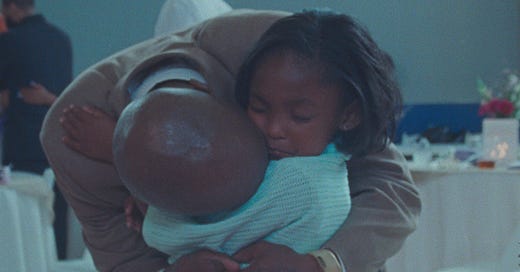“Daughters”: A Dance Reveals How Incarceration Ensures Destruction
The documentary is small in scope but monumental in meaning
Five-year-old Aubrey loves numbers, but not their meaning. She’s eager to share how she excels in school, how high she can count without making a mistake, how quickly she can do arithmetic. But the numbers aren’t just abstract sums she can recite. For Aubrey, they represent how many weeks she has to wait until she can see her father again, or how many years she has to grow without him until he returns home. “Seven’s a very close number to one,” she says at the beginning of the film, “but it's gonna take a long time ‘cause it’s in years.”
In Daughters, Aubrey is one of many young Black girls who has spent her childhood without her father due to incarceration. The documentary focuses on four girls who are reunited with their fathers who are in prison through the Date with Dad program, founded by co-director Angela Patton, which gives the girls the opportunity to see their fathers outside of the context of a carceral environment during a father-daughter dance.
The four girls all understand the destruction of their fathers’ incarceration differently — some hold idyllic images of the fathers that they’ve been forced to never truly know, some resent their fathers individually, some hold a deep existential pain knowing that this punishment will never be individual, but instead reverberate through their entire community to ensure the endless ubiquity of it. In turn, in the weeks leading up to the dance, the fathers are given the opportunity to process the personal truths that are withheld from their daughters in their absence. The pairs share commensurate perspectives that can only be placed in conversation through the film’s editing — the prison system is designed to intentionally make face-to-face dialogue impossible, to prevent these shared truths from ever grounding themselves.
Daughters is not concerned with the actions each father took to warrant incarceration, nor is it intent on exploiting the emotions of either party for narrative gain. The film understands that no one can do anything to deserve being treated as inhuman, nor does someone need to perform their emotion to justify the humanity that should be guaranteed by their existence. The camera imbues emotion through a respectful distance, allowing for a reflexive resonance without manipulating the real pain on screen. Our resulting pain is overwhelming but detached rather than lived, giving us the opportunity to feel every blow but affirming that our reaction as a voyeur will never be equal to the pain of the subjects. To us, the grief of lost time is felt through what is withheld, rooted in the real but abstracted as to not manipulate its subjects’ circumstance.
The distance between subject and viewer is fundamental to the maintenance of an ethical emotional relationship between the two and is essential to the articulation of a structural understanding rather than an individual one. The subjects are not specimens held under a microscope; rather, the gap that the film leaves forces us to recognize how the severance of families creates the stratification of communities.
The prison system is designed to appear as a means of deterrence, but the truth behind this myth is that social dominance is maintained not by deterring crime but instead through the consequences felt by marginalized communities. Prisoners are not paying a debt to society for their crimes — the true burden of punishment falls on their families, not just because of the emotional toll of their estrangement, but from the cycle that results from the dismantling of community. Prisons extract many things from their inmates (profit, time, labor), but their primary form of control is ensuring that the extraction of young men from their communities will guarantee the continuation of the cycle of crime. When fathers can’t touch or even see their families, is rehabilitation expected or even possible? Of course it isn’t, and it was never intended to be — the goal is the fracturing of their environment and the maintenance of the circumstances that assure crime in the first place.
While the scope of Daughters is small, it manages to articulate that the silhouette of the carceral system will be forever intertwined with the families that it separates, which ultimately results in an acceptance of the immortality of the system. Before her father has been released, 10-year-old Santana has already accepted the fact that he will be sent back to prison, saying that she won’t even cry when it happens the next time. Incarceration has ensured that an acceptance of its inevitability runs deep through the communities that it destroys, and that even moments of hope will always lie in its shadow.
When the night of the dance finally arrives, with each father and daughter in crisp suits and pretty dresses, they are forced to embrace in the cold windowless hallways that administer their absence. Isolation dominates their reunion because it is bounded by the denial of touch. A change to this reality must begin at the root — planting new seeds, because pruning the same old trees will still always yield the same fruit.
Daughters was released on August 14, 2024, and is currently streaming on Netflix.





Our fee structure? We bill by the hour.